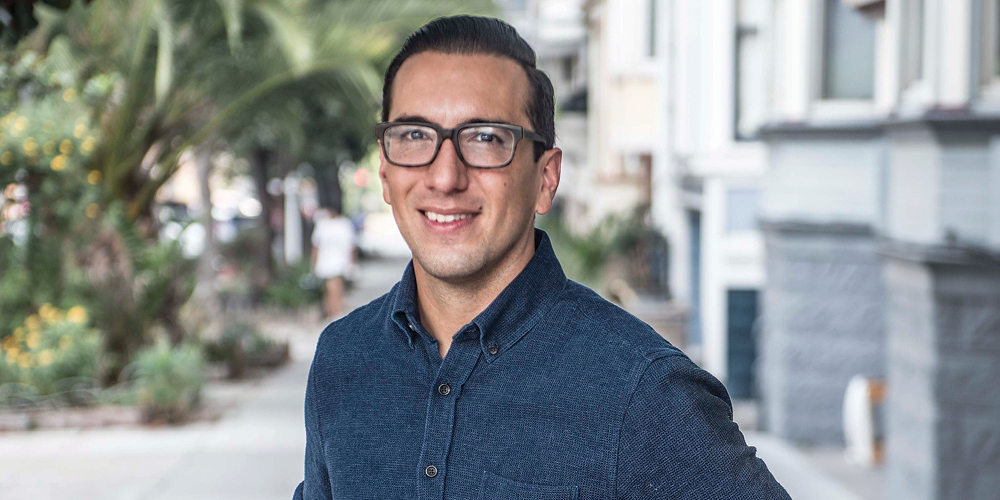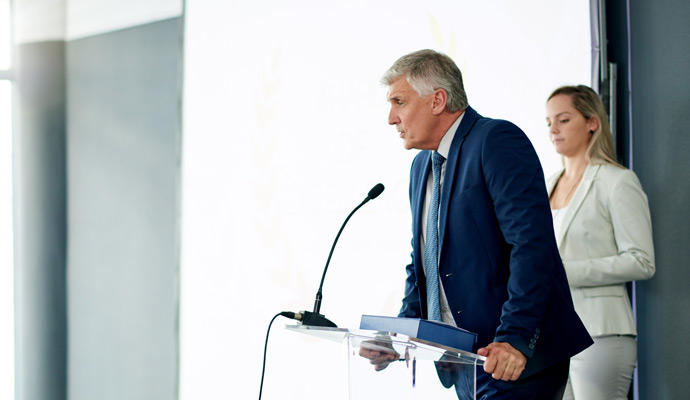Empathy: The glue we need to fix a fractured world
Stanford psychologist Jamil Zaki explains that whether we are dealing with business, politics, or personal matters, it’s possible — and advantageous — to train ourselves to be more empathic.
Jamil Zaki’s The War for Kindness wasn’t always a war. When the Stanford University psychology professor started writing his acclaimed book, which asserts that empathy is a skill that can be built, it was called Choosing Empathy. But then something happened that made the choice seem much more difficult than simply reaching for the top shelf of available emotional capacities.
In 2016, when Donald Trump stunned the world by winning the U.S. presidential election, he exposed deep, acrimonious, and seemingly unbridgeable chasms among people. The election was, at the time, the culmination of a series of such divisive events around the world. By 2016, the Syrian refugee crisis was at its height, with nations arguing over whether to tighten borders. The U.K. had voted to leave the European Union in 2016. And tens of thousands had perished in hate- and terror-driven attacks around the world, including in France; at the Pulse nightclub in Orlando, Fla.; and in Pakistan.
Forces in the world that were tearing everyone apart appeared to be at a powerful climax. People were not only angry, but seething. And they seemed to be actively embracing anger and rejecting empathy. In this environment, choosing empathy had become a radical act — a bold play for peace in a time of literal and figurative war.
Zaki’s interest in empathy sprang from a war of sorts in his own life. His parents divorced when he was a young boy, and their bitterness toward each other tugged at him. As they shuttled him from house to house in their suburban Massachusetts hometown and sometimes tried to get him to pick sides, he made a choice to instead try to understand their distinct perspectives. And as he worked at this, he realized that two seemingly oppositional realities could be true.
From this early life, Zaki went on to earn his bachelor’s degree in cognitive neuroscience from Boston University and his doctorate in psychology from Columbia University. He did a postdoctoral fellowship at Harvard University, and he became a husband and a father himself. In the psychology courses he teaches now at Stanford, including one called Becoming Kinder, and in his work as the director of the Stanford Social Neuroscience Lab, he points out that as he did with his parents, we can all train ourselves to be empathic.
And there’s good reason to do so, Zaki says. Our world is full of daily battles in which we’ve consciously or subconsciously sorted ourselves into “us” and “them” camps. Empathy creates links between camps, giving us collective power to accomplish more together than we ever could apart. These aren’t just feel-good ideas. Several academic studies show that empathic individuals excel professionally and experience greater subjective well-being. Research also reveals that the most successful workplace teams are those in which employees report high levels of psychological safety and interpersonal sensitivity. In this interview with strategy+business, Zaki shared more about his work and the strategies he recommends for building empathy.
S+B: Would you explain the differences between empathy, kindness, and niceness?
ZAKI: Empathy is, as psychologists understand it, an umbrella term that captures at least three ways that we connect with one another’s emotions. One is emotional empathy, which is vicariously catching somebody else’s feelings. Maybe someone stubs her toe, and you feel a little jolt of pain yourself; that would be emotional empathy. Cognitive empathy is your attempt to understand what someone else is feeling and why. And then empathic concern or compassion is your motivation to improve others’ well-being.
Kindness is an action that we pursue, and it’s split into two types. If I help you, but in a way that also helps me, that’s cooperation. If I help you in a way that doesn’t help me, or even involves me sacrificing something, that’s altruism.
Niceness, or politeness, is the avoidance of other people’s discomfort. Kindness and niceness can be the same, but they’re not always. For instance, in the workplace, it can feel uncomfortable to give difficult feedback to someone. But if you want the person to improve, the best thing that you can do is to say that difficult thing. This creates a direct conflict between niceness and kindness. Giving polite feedback, in that case, is actually unkind, because it deprives the person of an opportunity for growth.
S+B: The War for Kindness was published about a year ago, before COVID-19 and before the killing of George Floyd. Do you think we’re living in a more or less empathic world now than when you wrote the book?
ZAKI: Our most difficult moments force us to contend with our vulnerability and our mortality, and we realize how much we need each other. We’ve seen this during the pandemic and the continued struggle for racial justice. There has been an enormous amount of suffering but also an intense desire to come together, and a lot of mutual aid and support. This painful moment has produced a lot of progress and clarity around our values.
Yet modern life, especially in these pandemic times, makes it harder than ever to connect with each other, and this disconnectedness can erode our empathy. But we can fight back. We can work to empathize more effectively.
The pandemic, the economic collapse associated with it, and the fight for racial justice have increased all sorts of feelings, including empathy, anger, intolerance, fear, and stress. A big question for the next two to five years is which tide will prevail.
S+B: How do you think the fractiousness and disconnectedness that we see in these current political situations and social crises are replicated in workplaces?
ZAKI: I work with a lot of leaders and organizations, and I see three main problems. The first is in how people think. There’s this notion, symbolized most famously by the character Gordon Gekko in the movie Wall Street, that kindness and empathy are somehow fundamentally at odds with success. This mindset holds that in a world of ruthless competition, focusing on ourselves is the only way to get ahead, and sacrificing for others is bad for business.
Another problem is that there’s tribalism within organizations, especially larger organizations and those that are trying to put different groups of people with different goals under a single tent. For instance, I’ve worked with companies that include both scientists and people who are trying to market the scientists’ work. These two groups have the same overarching goal, but they often feel like they have totally different goals, and it’s often easier for them to see their differences than what they have in common. This sense of disconnectedness can create antipathy rather than empathy.
And third, there’s a paradox within management. People who are empathic tend to be nominated by their peers as natural leaders and tend to rise. But as they gain more power, they often shed their empathy.
S+B: Do you think that change emanates from within the individual, or do you think cultural forces and attitudes cause this to happen?
ZAKI: I think that they’re wound up together, but they can be separable. In experiments, the psychologist Michael Kraus at Yale has found that making people think of themselves as having high-status decreases their ability to read other people’s emotions. And another study by Adam GalinskyPDF at Northwestern demonstrates that giving one person even a temporary position of power will make that person temporarily worse at seeing other perspectives. So, even just thinking of yourself as powerful focuses you inward.
But there are also these broken but sticky theories that leadership requires a hard-nosed, unemotional approach. This thinking is almost entirely backward. Empathic leadership and transformative leadership are enormous keys to organizational success.
S+B: Can you talk a little bit more about how empathy is key to organizational success?
ZAKI: Starting in 2012, Google ran an internal analysis called Project Aristotle. The company was looking at what makes collaborative teams succeed. They thought it would be talent, but in fact, it was the psychological safety among the group and their interpersonal sensitivity, or ability to read each other.
It’s also the case that when employees perceive their organization or their boss as empathic, they are more creative, more productive, have greater morale and loyalty, and are even willing to work longer hours. There’s also a lot of evidence that when feedback, even difficult feedback, is delivered empathically, the people who receive it are better able to use it to develop and grow, because they don’t feel attacked. And there are connections between measures of organizational empathy and bottom-line success, including profits that a company draws.
A point here is that a business is like a crew team. In order to be competitive as a unit, it’s critical that everyone be rowing together. That togetherness is an absolute key to success.
S+B: What about in an academic setting, like the one you work in and that millions of students, teachers, professors, and parents are reinventing because of COVID-19? How do you keep everyone rowing together?
ZAKI: When the pandemic started, I was teaching a large introductory psychology class. My students, most of whom were first-year students, had just been asked to return home. They were under enormous stress, and they were lonely.
So what my teaching team tried to do was to send a clear message that a classroom is not just a place to learn, it’s also a place to feel community. We reshuffled our assignments and lectures to allow students to have more of a voice in the classroom. I cut down the percentage of lectures that were just me yammering on, and I invited much more discussion. We also changed our assignments from one-person assignments to group assignments to give students a chance to connect and work together.
S+B: Is there a connection, then, between empathy and innovation? You talk in your book about the role of imagination in helping people build empathy. Does that ability to imagine another perspective also enable innovation?
ZAKI: Absolutely. For instance, in many design firms, the first step employees take when they want to create something new and useful is to put themselves in the body and mind of the end-user. Through that simulation, they’re better able to innovate. This is called empathic design.
And there’s another way organizational empathy can foster innovation, which is by creating a feeling of safety. According to a study by researchers at Texas A&M University, when people feel that their leaders and managers are empathic, they spend more of their time taking risks. They feel safer trying out new ideas because they know that even if they stray off the path, they aren’t going to be scolded or shut down. And as a result, they are more productive and innovative.
S+B: But, to take Gordon Gekko’s side for a moment, can there be such a thing as too much empathy? Many managers “disconnect” to handle layoffs or performance issues among their staff. If a manager is naturally very empathic or works on developing empathy, can that emotional connection with employees get in the way of good business decisions?
ZAKI: Empathy is a skill that we can tune. In the workplace, when we’re in the position of doing something that causes harm, it can make us experience a lot of distress and guilt. We often respond to this by disconnecting. We try to turn off our emotions entirely. But this can leave others feeling enormously alienated. In fact, one study found that people who were laid off and felt that they were laid off without compassion were more likely to file wrongful termination claims.
But the other option doesn’t have to be that you feel overwhelmed by emotion. People in leadership positions need to make sure they’re not draining themselves by taking on other people’s pain. You can’t pour out of an empty cup.
This is where tuning empathy comes into play. There are ways to give bad news compassionately, and it turns out that it makes a difference. People can actually feel grateful to somebody who lays them off if it’s done with procedural justice and with an eye toward really creating opportunities for them in the future.
S+B: I was intrigued by the story you told in your book about using a mental health app to safely share with an anonymous stranger your anxieties about finishing up your book. Do you think there’s a way to create safe, stigma-free spaces at work for people to release their feelings, or is it best to keep those conversations out of the workplace?
ZAKI: Well, first of all, I think we need [those conversations] now more than ever. People at work have a unique connection to each other’s experience and a unique shared understanding, because they have shared circumstances.
Now, it can be dangerous if this venting turns into a ring of gossip, and that’s what happens when we don’t systematize peer support. If people don’t have a system and support for talking to each other, they’ll do it at happy hours and in hallways. A more productive idea is to create networks — spaces and time for people to support one another and share their experiences.
One example that I read about was at Johns Hopkins, where the hospital’s management asked employees, “Who among your colleagues do you find really supportive?” They found these “glue people” in the organization, gave them some training, and then — this is crucial — dedicated paid time for them to offer support to their colleagues.
S+B: You talk about the importance of getting to know those we think of as “other” in order to build empathy and bridge gaps. How does this translate to the workplace?
ZAKI: I’ve developed a set of kindness challenges, these little empathy-building exercises based on my book, and I call one of them “disagreeing better.” The idea is to move beyond the source of difference and to try to find some common ground. And the way that I encourage people to do this is by telling stories. There’s evidence from political science and the practice of “deep canvassing” that storytelling is a powerful way to bridge differences.
Deep canvassing is an approach that’s been pioneered in the past couple of years, where you go door-to-door talking about an issue, and instead of spewing statistics or implying that anyone who disagrees with you is a bad person, you ask people to share some of their experiences. For instance, in canvassing for trans rights, you might ask, “Have you ever felt like you were left out? Have you ever felt like you couldn’t express yourself?” You listen to the person’s story and then share some of your story, too. And you end up finding a point of common ground and then using that point of common ground almost like an Archimedean point or fulcrum.
Going back to the example of scientists and marketing people in a company who are working on the same product but feel at odds with each other, let’s say that the product they’re making is a medication or technology that helps people in some way. Enthusiasm for that prosocial benefit, that mission of helping others, might be something that the two groups share, and they can come to see that by telling each other stories about their motivations. Finding that commonality and holding onto it, as opposed to just staying on the surface, can be a deep way to bridge differences.
S+B: And how do you get people to engage in telling these stories that move them to this point of understanding?
ZAKI: Psychologists have designed ways to get conversations to deepen systematically. There’s this paradigm that Art Aron created in the 1990s called the Fast Friends paradigm. It’s a list of 36 questions that go deeper and deeper.
It starts out with a question like, “Who would you want to have dinner with if you could choose anyone living or dead?” Then it gets all the way to a question like, “What do you value most in life? What do you fear most?” It takes 30 to 60 minutes to have the conversation, and it basically creates friendship out of nowhere, because it gets people to talk about what really matters to them quite quickly.
This is what deep canvassing is about. It gets you right into the guts of what makes all of us similar, which is hope and fear, our feelings.
S+B: When it comes to empathy in the workplace, how would you go about identifying the potential empathic influencers who can be role models?
ZAKI: Some organizations have mapped their communities of helpers. They’ve asked their people to identify others within the company who’ve helped them in the past couple of weeks with anything at work, and also to say whom they’ve helped. By doing this, they’ve been able to identify those glue people, the natural support providers within their organizations.
We can use a similar approach to ask, “Who has made you feel cared for and understood? Who’s made you feel heard recently?”
S+B: How do you make systems and practices like these stick — not only encouraging empathy, but making it an expectation?
ZAKI: One way to encourage empathy is through reward. I often think that the loudest voices in our culture tend not to be the kindest and most empathic. So I often encourage leaders to make empathy loud. If they see someone or if they learn about someone helping others, they can talk about it and recognize that person in an all-hands meeting.
Another way to do it is when thinking about promotions and bonuses and other material rewards. Factor in not just an individual’s output but also the way they have facilitated other people’s output.
S+B: COVID-19 has forced workers all over the world to step out from behind a figurative curtain, revealing themselves in their personal settings. And in seeing these realities, employers have had to exercise some compassion. But do you think compassion fatigue will set in or already has? How can managers actively combat it?
ZAKI: Leaders need to settle in for another long season of prioritizing the humanity of the people who work with and for them. Employees are going to remember for years how their leaders and managers showed up or did not show up for them. There are some organizations whose cultures are going to crumble through a lack of connection during this time, and there are others whose organizational cultures will be renewed and strengthened.
Leaders need to settle in for another long season of prioritizing the humanity of the people who work with and for them.”
To combat compassion fatigue, leaders need to first care for themselves. Empathy starts at home. It’s critical that people in leadership positions make sure they’re not draining themselves, because that’s actually not setting an example for employees to follow.
The second thing leaders need to do is to acknowledge the ways that their struggles overlap with their employees’ struggles. My kids have been running around during a lot of my Zoom meetings, and at first I was trying to keep them out of the picture, doing the BBC Dad thing. But we’re all BBC Dad or Mom now. And I think we just have to let the lines between work and home blur a little. It’s kind of nice that my colleagues have met my kids and I’ve met theirs and that we know a little bit more about each other’s lives and can talk about that.
It’s important to make that space. If you need to talk shop with colleagues for 30 minutes, book 40, because it’s important to start every conversation these days by checking in and giving people room to assert their humanity and tell us about what they’re going through.
I think this also needs to come in the form of flexibility as a standard policy. It’s not enough to check in for 10 minutes at the top of a weekly meeting and then expect the exact same thing from your employees that you would otherwise. If someone’s caring for a sick relative or caring for children, make room for that. The compassion you give might be repaid 10-fold in loyalty, morale, connection, and a sense of identification and togetherness.
S+B: You write in your book that technology “can make it harder for us to see one another. But used differently, it can do just the opposite.” How have you seen this come true in these pandemic times?
ZAKI: One thing that’s been really humanizing about videoconferencing is not just using it to have face-to-face conversations, but using it to replicate the side-by-side experiences that we sometimes have, like watching movies together, cooking dinner, or just having a glass of wine. Hanging out on video can be more powerful than just having a conversation, because when you’re together with your friends and colleagues, you’re not just constantly talking. There are lulls, and those lulls are the space in which togetherness occurs.
Let me also say, though, that my feeling about digital togetherness was a lot more optimistic in months one and two of the pandemic. I think a lot of us now have a lot of Zoom fatigue. So I think it’s important to be flexible and to ask ourselves which digital connections are working for us, with different people, in different settings. Is it a phone call? Is it a text? Is it a video chat? When is each appropriate? Fifty hours a week of Zoom meetings is not healthy for anybody. We need to be mindful about when digital technologies are bringing us together and when they’re stressing us out.
S+B: How optimistic are you about the potential for people to become more empathic and for this to change our world and our businesses for the better?
ZAKI: Imagine sending the front page of the New York Times from today to yourself a year ago. We’re living in the strangest time I can recall in my adult life, so of course that’s changed my outlook about a lot of things, including empathy.
I’m experiencing an intensification of what I felt when the book published, which was neither optimistic nor pessimistic. I don’t know what the future holds. I really do see big, powerful cultural trends that are continuing toward extremism: intolerance, division, isolation, alienation, and anxiety.
I’ve also seen enormous effort and enormous progress toward humanizing diverse voices and toward affirming our desire for connection. The loneliness of this time has highlighted how much we desperately need each other.
How things turn out is up to us more than we know it is. If I have anything to say to those reading this interview, it’s just to remember that you are part of creating this future. Your decisions, and mine, and ours will create it.
Maybe business will lead the way. I’ve never been asked by so many leaders in so many different organizations for concrete help injecting the science of empathy into the way that they work. If we can reform and build more connected work cultures, that momentum can spread beyond work and into our culture at large.





